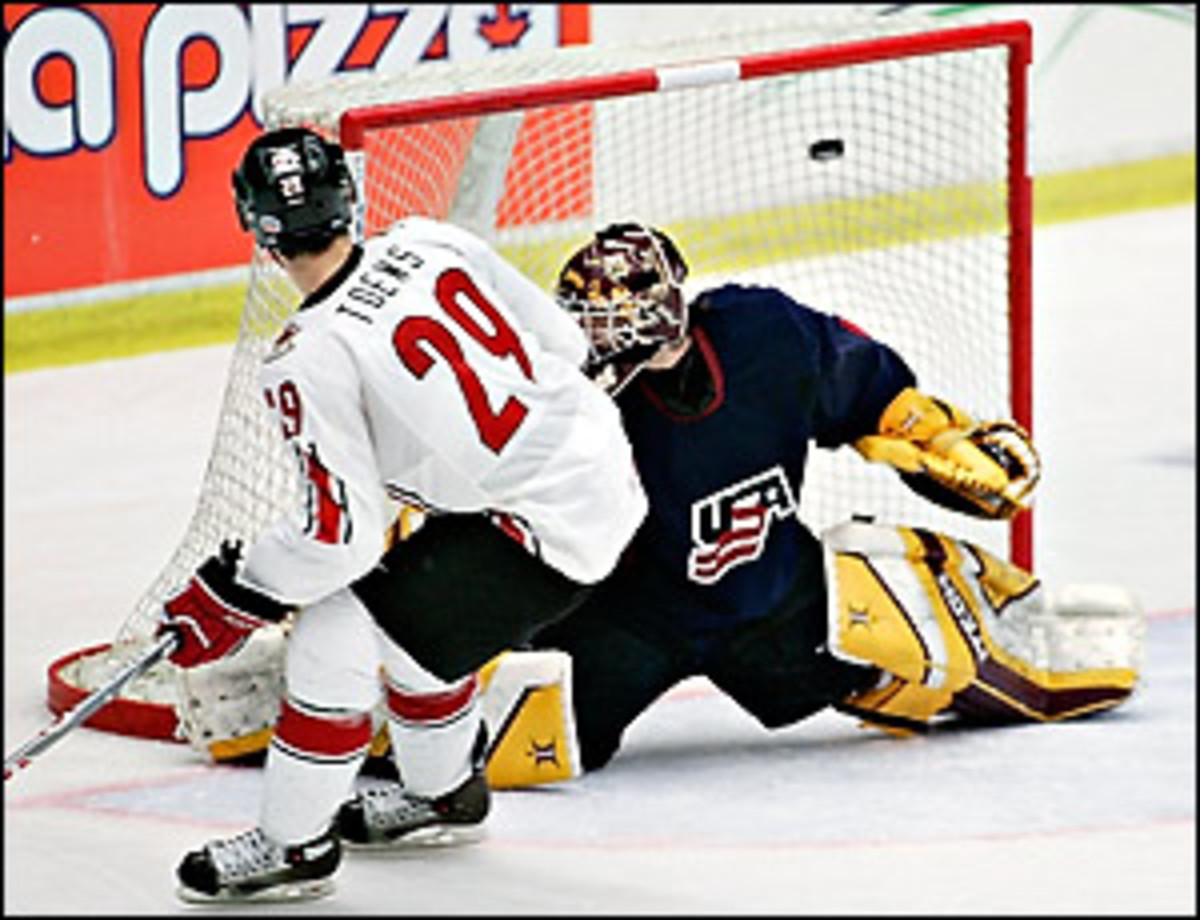Junior achievement
Whatever Jonathan Toews wants, now's the time to ask. Canada owes him one.
The kid with ice in his veins is the country's newest hockey icon after he connected for a shootout hat trick in Canada's 2-1 win over the United States in the semifinals of the 2007 World Junior Championships on Wednesday.
After watching Toews light the lamp on Canada's third, fifth and seventh attempts, I'm thinking the NHL should follow the IIHF's lead and adopt a similar shootout policy.
The league's current system -- which forces a team to use every available shooter at least once before allowing anyone to take a second attempt -- pays lip service to the concept of a team game, but what's the point? The reality is that the shootout is an individual skills competition, not a team event. And while every once in a blue moon you might see something spectacular from a late-round conscript like Rangers defender Marek Malik, wouldn't it be more thrilling to watch the crafty Alexander Ovechkin or Minnesota's Mikko Koivu or Dallas' Jussi Jokinen work their magic, say, every third attempt?
I understand the argument for rewarding depth of offensive talent, but the shootout is about entertainment, not competitive integrity. And for a league that needs to explore any opportunity that might help promote its stars, an avenue that provides more highlight-reel fodder is certainly worth exploring.
In case you missed, the Canada-U.S. semifinal was a magnificently played match, one that couldn't be decided through 60 minutes of regulation or 10 minutes of overtime. Heroes in the making roamed both sides of the ice. American defender Jack Johnson was a monster, dominating the play with thunderous hits and precision passing. The goaltenders, Carey Price for Canada and Jeff Frazee for the Americans, were each bested just once through 70 minutes of gut-check time.
But as good as they were, it was Toews who crafted a legend.
Three times, the University of North Dakota star was given a shot with the game on the line. Three times he scored.Twice, the Americans answered his challenge. On the third, they failed, sending Canada on to face Russia for gold on Friday.
There was nothing fancy about his success, no ankle-breaking dekes. Toews was instead a model of precision shooting, coolly exploiting what small openings Frazee offered him. Low blocker. High glove. Low glove.
Toews gave a hint of what he could do in this situation with a penalty shot goal that broke the back of the Americans in Canada's 6-3 round-robin victory. And when he scored on his first attempt on Wednesday, coach Craig Hartsburg had his go-to guy. Only the most savvy international hockey fans knew beforehand that players could be used as often in the shootout as the coach wanted. So when you've got a hot hand, you run with it.
Three shots. Three goals.
Instant legend.
Give Toews full marks for taking advantage of his big moment. After all, if Canada had brought its best possible team, he might not have gotten a sniff at the shootout.
As talented as this squad is, it's missing at least a half-dozen eligible players currently in the NHL. Hard to imagine the games would have been so closely contested if Jordan Staal, Gilbert Brule, Guillaume Latendresse, Marc-Edouard Vlasic and the NHL's leading scorer, Sidney Crosby, were part of the Canuck contingent in Leksand, Sweden.
Of course, these kinds of exclusions are par for the course for the Canadians. For example, the crash-and-burn squad that finished eighth in 1998 might have fared a little better had the top two picks of the 1997 draft, Joe Thornton and Patrick Marleau, not been playing in the NHL.
Is the shootout a lousy way to decide who advances out of such an important game as a World Junior semifinal? Despite the white-knuckle thrill of the spectacle, most American fans -- and a large number of Canadians -- certainly think so.
But there's no reason to gripe about it. The tournament rules were set well in advance, and everyone involved knew how things worked. Both teams had 70 minutes to get it done in regulation and OT. Most times, that's enough.
So why not let them keep playing on the rare occasions when 70 minutes isn't enough? You have to consider the compressed scheduling of this tournament. The playoff round features three games in four nights for the two teams that advance, and this after playing four round-robin games in six nights. Asking them to play any or all of those games indefinitely just isn't practical.
And say what you will, but this format makes for a far more compelling tournament than back in the days where it was strictly a round-robin event, with the best record capturing the gold.
It says a lot about the current state of American hockey that the country now produces enough world-class junior-aged players to create controversy during the selection process. The questions that were asked when the team was named in early December are sure to grow louder in the wake of the disappointment to Canada.
Case in point: When winger Bobby Ryan was left off the roster, a few critics wondered how USA Hockey could overlook the gifted scorer who was selected second overall by Anaheim at the 2005 draft.
Although he played -- sparingly -- on the 2006 American squad, Ryan's skating and character were found to be wanting, and Team USA went with Ryan Stoa instead of the veteran.
Would Bobby Ryan have made a difference in the tournament, especially in Wednesday's shootout loss? No way to know for sure, but the Owen Sound Attack forward certainly sent USA Hockey a message. Ryan was named the OHL Player of the Week for the week after scoring three goals and eight points in just two games.





